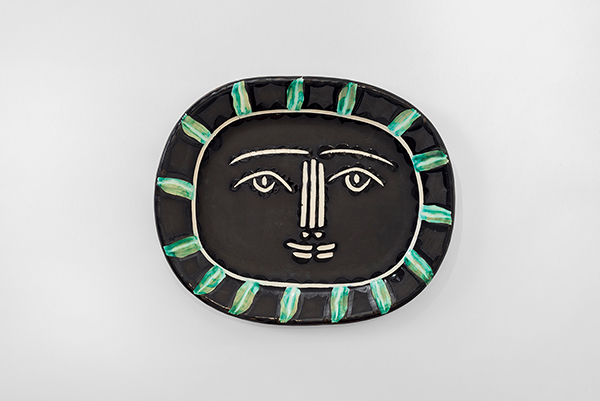With an artistic career spanning 70 years, Pablo Picasso is estimated to have created a staggering 50,000 artworks comprising paintings, sculptures, ceramics, and drawings. Stylistically, the artist drew inspiration from a wide array of areas, experimenting with neoclassicism, cubism, surrealism, and collage. In the early 1900s, Picasso co-founded the Cubist movement with George Braque, and later coined the artistic techniques of assemblage and collage.
Throughout his 25-year collaboration with the Madoura Pottery workshop in Vallauris, Pablo Picasso produced over 600 ceramic pieces, working up until his death in 1973. Picasso used this later stage of his career as a time for introspection, referencing and building upon themes and motifs used in his earlier works. Favouring female muses, human faces, and whimsical animals as the basis for his ceramic production, Picasso proves his stylistic versatility and limitless appeal. For example, Grey Face (Visage Gris) made in 1953 reflects the artist’s wider evolution as a craftsman. Situated at the latter end of his artistic production, Grey Face demonstrates many of Picasso’s earlier influences, combining to create a unique representation of his body of work. Multi-layered, amalgamated, and intricate, Grey Face holds connections to moments both early and late in the artist’s life.
The years spanning 1901-1904, for example, were recognised as Picasso’s Blue Period. These works are characterised by a frugal use of cool blues, greens, and whites and sombre subject matter covering blindness, prostitution, and poverty. Portrait of Suzanne Bloch, painted in 1904, depicts the Parisian singer from mid-torso upward. Idiosyncratic of the Blue Period, the sitter is presented as austere and unsmiling in her portrait. Her dark hair and shirt dominate the canvas, absorbing any remaining light floating around the composition. Dimly lit, the picture plane is crowded with feverish brushstrokes implemented in muddy greens and greys. A hint of lighthearted colour remains, however, in the soft peach-toned lips of Bloch’s youthful face. Certainly, Grey Face’s dark undertones and repeated green strokes echo Picasso’s mournful Blue Period.

Portrait of Suzanne Bloch, 1904

Nude Woman in a Red Armchair, 1932
Further, Picasso’s later works combine elements of Cubism and Surrealism, bolstered by an influence of African artefacts and Iberian sculpture. Nude Woman in a Red Armchair, produced in 1932, depicts a figure inspired by Marie-Thérèse Walter, the artist’s young lover and muse. The figure is composed of soft, curvilinear forms, contrasting with the dark diagonal lines receding into the background behind her. Her body is voluptuous, with the shape of the armchair mimicking her own curves in a display of adolescent sensuality. Additionally, the simplistic formation of her facial features share similarities with those of Grey Face. The two depictions share almond-shaped eyes and the carefully placed lines of a small mouth and striking nose. In suggesting the smooth, supple quality of the model’s skin, the painting encourages a tactile understanding of Walter’s body, appealing to the viewer’s sense of touch.
Indeed, the tactility of Nude Woman in a Red Armchair is better understood when paired with the physical form of Grey Face, a rectangular dish formed out of earthenware clay. The very essence of Grey Face is tactile, with its functionality as an everyday object inherently associated with physical contact. As a functional object, Grey Face, propels Picasso’s work into the viewer’s domain. Unique in its double-identity as a utilitarian object and work of art, Grey Face welcomes associations of viewer’s own kitchenware. Representative of Picasso’s entire career, the piece adopts multiple stylistic elements simultaneously, subtly pairing the melancholic Blue Period with a Cubist and Surrealist abstraction
(By Eleanor Lerman)
